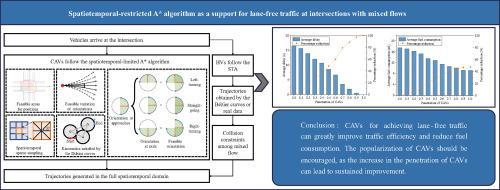Improving the capacity of intersections is the key to enhancing road traffic systems. Benefiting from the application of Connected Automated Vehicles (CAVs) in the foreseeing future, it is promising to fully utilize spatiotemporal resources at intersections through cooperative and intelligent trajectory planning for CAVs. Lane-free traffic is currently a highly anticipated solution that can achieve more flexible trajectories without being limited by lane boundaries. However, it is challenging to apply efficient lane-free traffic to be compatible with the traditional intersection control mode for mixed flow composed of CAVs and Human-driving Vehicles (HVs). To address the research gap, this paper proposes a spatiotemporal-restricted A∗ algorithm to obtain efficient and flexible lane-free trajectories for CAVs. First, we restrict the feasible area of the heuristic search algorithm by considering the feasible area and orientation of vehicles to maintain the trajectory directionality of different turning behaviors. Second, we propose a spatiotemporal sparse sampling method by defining the four-dimensional spatiotemporal grid to accelerate the execution of the heuristic search algorithm. Third, we consider the motions of HVs as dynamic obstacles with rational trajectory fluctuation during the process of trajectory planning for CAVs. The proposed method can retain the advantage of efficiently exploring feasible trajectories through the hybrid A∗ algorithm, while also utilizing multiple spatiotemporal constraints to accelerate solution efficiency. The experimental results of the simulated and real scenarios with mixed flows show that the proposed model can continuously enhance traffic efficiency and fuel economy as the penetration of CAVs gradually increases.


